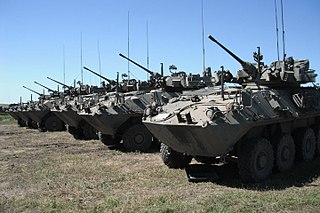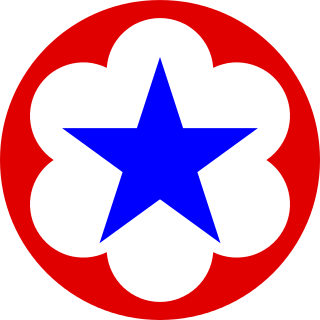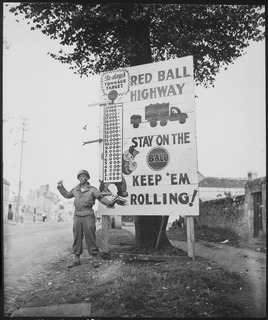
A battalion is a military unit, typically consisting of 300 to 1,000 soldiers commanded by a lieutenant colonel, and subdivided into a number of companies. In some countries, battalions are exclusively infantry, while in others battalions are unit-level organizations.

The LAV II Bison and Coyote are armoured cars built by General Dynamics Land Systems Canada for the Canadian Forces. It is based on the Mowag Piranha 8x8.

The Royal New Zealand Army Logistic Regiment , is the New Zealand Army's main military Logistics and combat service support (CSS) element. It is the largest regiment in the NZ Army.

The Transportation Corps is a combat service support branch of the U.S. Army. It is responsible for the movement of personnel and material by truck, rail, air, and sea. It is one of three U.S. Army logistics branches, the others being the Quartermaster Corps and the Ordnance Corps. The Corps was established in its current form on 31 July 1942, with predecessor services dating back to the American Civil War. Currently headquartered at Fort Lee, Virginia, it is the second-largest branch of the Army. The officer in charge of the branch for doctrine, training, and professional development purposes is the Chief of Transportation (COT), a position currently held by Brigadier General James M. Smith. The Corps's motto is "Nothing Happens Until Something Moves".

The United States Army Quartermaster Corps, formerly the Quartermaster Department, is a sustainment, formerly combat service support (CSS), branch of the United States Army. It is also one of three U.S. Army logistics branches, the others being the Transportation Corps and the Ordnance Corps.

The United States Army Ordnance Corps, formerly the United States Army Ordnance Department, is a sustainment branch of the United States Army, headquartered at Fort Lee, Virginia. The broad mission of the Ordnance Corps is to supply Army combat units with weapons and ammunition, including at times their procurement and maintenance. Along with the Quartermaster Corps and Transportation Corps, it forms a critical component of the U.S. Army logistics system.

The Willys MB and the Ford GPW, both formally called the U.S. Army Truck, 1⁄4-ton, 4×4, Command Reconnaissance, commonly known as the Willys Jeep, Jeep, or jeep, and sometimes referred to by its supply catalogue designation G503, were highly successful American off-road capable light military utility vehicles, built in large numbers to a single standardized design, for the United States and the Allied forces in World War II from 1941 until 1945.

The San Francisco Port of Embarkation (SFPOE) was a United States Army command responsible for movement of supplies and troops to and from the Pacific during World War II with extensive facilities in the San Francisco area. SFPOE was established 6 May 1932 and disestablished 1 October 1955. It was originally composed of the long term Pacific terminal at Fort Mason that had been the home port and terminal for the Pacific Army Transport Service ships. That facility was far too limited to serve the requirements of a full port of embarkation. In 1940 the port began expansion to include Army owned and leased facilities throughout the San Francisco Bay area and for a time sub ports at Seattle and Los Angeles. Those eventually became separate commands as the Seattle Port of Embarkation and Los Angeles Port of Embarkation.
Fort Holabird was a United States Army post in the city of Baltimore, Maryland, active from 1918 to 1973.

The New York Port of Embarkation (NYPOE) was a United States Army command responsible for the movement of troops and supplies from the United States to overseas commands. The command had facilities in New York and New Jersey, roughly covering the extent of today's Port of New York and New Jersey, as well as ports in other cities as sub-ports under its direct command. During World War I, when it was originally known as the Hoboken Port of Embarkation with headquarters in seized Hamburg America Line facilities in Hoboken, New Jersey, the Quartermaster Corps had responsibility. The sub-ports were at Boston, Baltimore, Philadelphia and the Canadian ports of Halifax, Montreal and St. Johns. The World War I port of embarkation was disestablished, seized and requisitioned facilities returned or sold and operations consolidated at the new army terminal in Brooklyn. Between the wars reduced operations continued the core concepts of a port of embarkation and as the home port of Atlantic army ships. With war in Europe the army revived the formal New York Port of Embarkation command with the New York port, the only Atlantic port of embarkation, taking a lead in developing concepts for operations.

The Army Service Forces was one of the three autonomous components of the United States Army during World War II, the others being the Army Air Forces and Army Ground Forces, created on 9 March 1942. By dividing the Army into three large commands, the Chief of Staff, General George C. Marshall, drastically reduced the number of officers and agencies reporting directly to him. The Army Service Forces brought together elements of five different components of the Army: elements of the War Department General Staff (WDGS), especially its G-4 division ; the Office of the Under Secretary of War; the eight administrative bureaus; the nine corps areas, which became service commands; and the six supply arms and services, which became known as the technical services. The Army Service Forces was initially known as the United States Army Services of Supply but the name was changed on 12 March 1943, as it was felt that the term "supply" did not accurately describe the broad range of its activities. The Army Service Forces was abolished on 11 June 1946 and most of its functions were taken over by the War Department General Staff.

The United States Army Transport Service (ATS) was established as a sea-going transport service that was independent of the Navy Department. ATS operated army transport ships for both troop transport and cargo service between United States ports and overseas posts. This service is often confused with the Army Transportation Service, created in France in 1917 to manage American Expeditionary Forces transport. ATS was a branch of the Quartermaster Corps responsible for land and water transport, becoming a separate United States Army Transportation Corps on July 31, 1942.

The 1919 Motor Transport Corps convoy was a long distance convoy carried out by the U.S. Army Motor Transport Corps that drove over 3,000 mi (4,800 km) on the historic Lincoln Highway from Washington, D.C., to Oakland, California and then by ferry over to end in San Francisco.

Colombey-les-Belles Aerodrome, was a temporary World War I airfield in France used by the Air Service of the American Expeditionary Force. It was located near Colombey-les-Belles, in the Meurthe-et-Moselle department in north-eastern France.
5 Service Battalion, or 5e Bataillon des services in French, is a deployable field unit of the Canadian Forces. It provides second and limited third line Combat Service Support to units throughout 2nd Canadian Division. Located at CFB Valcartier, 5 Svc Bn is composed of a battalion headquarters and four functional companies: Transportation, Supply, Maintenance, and Administration. Administration Company is unique in that it provides first line support to the battalion itself, while the remaining companies provide second and limited third line support to units across 2 CA Div.

Romorantin - Pruniers Air Detachment is a French Air Force military facility, located 6 kilometres (3.7 mi) southwest of Romorantin-Lanthenay, in the Loir-et-Cher department of central France.

Harry Lovejoy Rogers was an officer in the United States Army. A specialist in quartermaster and food service activities, Rogers attained the rank of major general, and was most notable for his service as chief quartermaster of the American Expeditionary Forces during World War I and Quartermaster General of the United States Army from 1918 to 1922.

American logistics in the Northern France campaign played a key role in the Allied invasion of northwest Europe during World War II. In the first seven weeks after D-Day, the Allied advance was slower than anticipated in the Operation Overlord plan because the well-handled and determined German opposition exploited the defensive value of the Normandy bocage country. The Northern France campaign officially commenced on 25 July, the day First United States Army began Operation Cobra, which saw the breakout from the Normandy lodgment, and ended on 14 September.



















